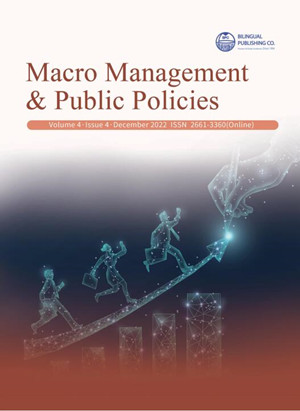-
926
-
365
-
267
-
265
-
264
Dazed and Confused: The Impact of Multinational Firms on Local Labor Markets
DOI:
https://doi.org/10.30564/mmpp.v4i4.4999Abstract
In this high-speed globalization era, the opportunities for multinational companies (MNCs) have become vast. In such situation, these companies can obtain maximum profit only if they know how to use workforce properly. This paper aims at analyzing how these MNCs can use international workforce without violating ethics, universal labor rights, and human resource rules. For this purpose, two most favored countries i.e., China and Indonesia have been taken and compared throughout the paper. The first part of this paper deals with the introduction of the profile of above mentioned two countries and opportunities to the MNCs. The second part deals with the roles of institutions in dealing with labor workforce. The third part indicates divergent paths and the convergence of the globalization with its impact over host countries. The final part concludes the entire discussion in a few paragraphs. The entire paper has been developed keeping the scholarly work, journal articles and critical analysis factor under consideration.
Keywords:
Multinational companies; Labor; Human resource management; Industrial relationReferences
[1] Peretz, H., Morley, M.J., 2021. A Preliminary Test of the Impact of De-Globalization on MNC Performance. Management and Organization Review. 17(2), 412-428.
[2] Collings, D.G., Mellahi, K., Cascio, W.F., 2019. Global talent management and performance in multinational enterprises: A multilevel perspective. Journal of Management. 45(2), 540-566.
[3] Lee, K., Wong, C.Y., Intarakumnerd, P., et al., 2020. Is the Fourth Industrial Revolution a window of opportunity for upgrading or reinforcing the middle-income trap? Asian model of development in Southeast Asia. Journal of Economic Policy Reform. 23(4), 408-425.
[4] Haeruddin, M., Mansur, M.A.R., Mansur, M., et al., 2020. Keeping up with the CISG: A Case of Indonesia. Iranian Economic Review. 24(4), 923-933.
[5] Podgorodnichenko, N., Edgar, F., McAndrew, I., 2020. The role of HRM in developing sustainable organizations: Contemporary challenges and contradictions. Human Resource Management Review. 30(3), 100685.
[6] Meijer, H., 2022. Awakening to China’s Rise: European Foreign and Security Policies toward the People’s Republic of China. Oxford University Press.
[7] Wang, K., Chen, Z., 2020. Infrastructure and regional economic growth in the One Belt and One Road regions: a dynamic shift-share approach. Development Studies in Regional Science. Springer, Singapore. pp. 221-241.
[8] Tomaskovic-Devey, D., Rainey, A., Avent-Holt, D., et al., 2020. Rising between-workplace inequalities in high-income countries. Proceedings of the National Academy of Sciences. 117(17), 9277-9283.
[9] Liu, K., 2018. Chinese manufacturing in the shadow of the China–US trade war. Economic Affairs. 38(3), 307-324.
[10] Trebilcock, M., Wong, S., 2018. Trade, technology, and transitions: Trampolines or safety nets for displaced workers? Journal of International Economic Law. 21(3), 509-545.
[11] Verico, K., Pangestu, M.E., 2021. The economic impact of globalisation in Indonesia. Globalisation and its Economic Consequences. Routledge. pp. 76-102.
[12] Zhu, Y., Malcolm, W., Tong, Q.F., 2011. Employment Relations with Chinese Characteristics: The Role of Trade Unions in China. International Labour Review. 150(1), 127-143. http://search.proquest.com.dbgw.lis.curtin.edu.au/docview/888057910?accountid=10382
[13] Gulzar, S., Mujtaba Kayani, G., Xiaofen, H., et al., 2019. Financial cointegration and spillover effect of global financial crisis: A study of emerging Asian financial markets. Economic research-Ekonomska istraživanja. 32(1), 187-218.
[14] Tambunan, T.T., 2019. The impact of the economic crisis on micro, small, and medium enterprises and their crisis mitigation measures in Southeast Asia with reference to Indonesia. Asia & the Pacific Policy Studies. 6(1), 19-39.
[15] Basri, C., Hill, H., 2020. Making economic policy in a democratic Indonesia: The first two decades. Asian Economic Policy Review. 15(2), 214-234.
[16] Fu, X., Emes, D., Hou, J., 2021. Multinational enterprises and structural transformation in emerging and developing countries: A survey of the literature.International Business Review. 30(2), 101801.
[17] Roy, T.K., Quazi, A., 2022. How and why do MNCs communicate their corporate social responsibility in developing countries? Evidence from Bangladesh. Competition & Change. 26(3-4), 384-406.
[18] Forcadell, F.J., Aracil, E., 2019. Can multinational companies foster institutional change and sustainable development in emerging countries? A case study. Business Strategy & Development. 2(2), 91-105.
[19] Lyan, I., Frenkel, M., 2022. Industrial espionage revisited: Host country–foreign multinational corporation legal disputes and the postcolonial imagery. Organization. 29(1), 30-50.
[20] Petricevic, O., Teece, D.J., 2019. The structural reshaping of globalization: Implications for strategic sectors, profiting from innovation, and the multinational enterprise. Journal of International Business Studies. 50(9), 1487-1512.
[21] Alves, A.C., Lee, C., 2022. Knowledge Transfer in the Global South: Reusing or Creating Knowledge in China’s Special Economic Zones in Ethiopia and Cambodia?. Global Policy. 13, 45-57.
[22] Menon, S., Sanjana, T., Sudhesh, N.T., 2022. Changing Environment and Workplace Well-being among MNC Employees in Bangalore: A Promising Survey. IAHRW International Journal of Social Sciences Review. 10(1), 26-31.
[23] Buch, C.M., Goldberg, L.S., 2020. Global banking: Toward an assessment of benefits and costs. Annual Review of Financial Economics. 12(1), 141-175.
[24] Vincent, S., Bamber, G.J., Delbridge, R., et al., 2020. Situating human resource management in the political economy: Multilevel theorising and opportunities for kaleidoscopic imagination. Human Resource Management Journal. 30(4), 461-477.
[25] Zhang, J.J., 2022. American multinational corporations and the US-China trade war. Research Handbook on Trade Wars. Edward Elgar Publishing. pp. 252-270.
Downloads
How to Cite
Issue
Article Type
License
Copyright © 2022 Author(s)

This is an open access article under the Creative Commons Attribution-NonCommercial 4.0 International (CC BY-NC 4.0) License.




 M. Ikhwan Maulana Haeruddin
M. Ikhwan Maulana Haeruddin

